
HMAS Bataan (D9/I91/D191) was a Tribal-class destroyer of the Royal Australian Navy (RAN). Laid down in 1942 and commissioned in 1945, the destroyer was originally to be named Chingilli or Kurnai but was renamed prior to launch in honour of the US stand during the Battle of Bataan.
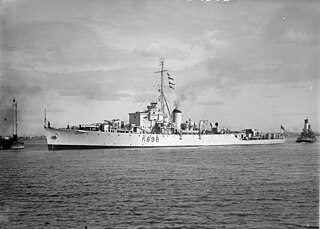
HMAS Condamine (K698/F698), named for the Condamine River in Queensland, was a River-class frigate of the Royal Australian Navy (RAN). Commissioned in 1946, Condamine served in the Korean War. The ship was paid off in 1955, and sold for scrap in 1961.

HMAS Culgoa (K408/F408/A256), named for the Culgoa River, was a Modified River -class frigate that served in the Royal Australian Navy (RAN).

HMAS Murchison (K442/F442) was a Modified River or Bay-class frigate of the Royal Australian Navy (RAN). The ship was laid down in 1943, but not commissioned until after the end of World War II. Murchison fought in the Korean War, was decommissioned in 1956, and sold for scrap in 1961.
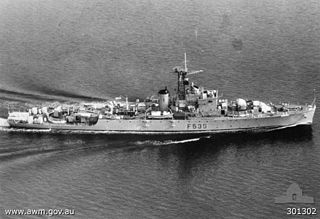
HMAS Shoalhaven (K535/M535/F535), named for the Shoalhaven River in New South Wales, was a modified River-class frigate of the Royal Australian Navy. She was laid down by Walkers at Maryborough on 18 December 1943, launched on 14 December 1944 by Senator Dorothy Tangney and commissioned at Urangan Pier in Hervey Bay in Queensland on 2 May 1946. Her first commander was Commander Rodney Rhoades.

HMAS Inverell, named for the town of Inverell, New South Wales, was one of 60 Bathurst-class corvettes constructed during World War II, and one of 36 initially manned and commissioned solely by the Royal Australian Navy (RAN).

HMS Vengeance (R71) was a Colossus-class light aircraft carrier built for the Royal Navy during World War II. The carrier served in three navies during her career: the Royal Navy, the Royal Australian Navy, and the Brazilian Navy.
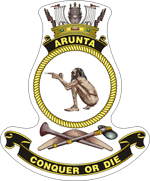
HMAS Arunta (I30/D5/D130) was a Tribal-class destroyer of the Royal Australian Navy (RAN). Named for the Arrernte Aboriginal peoples, the destroyer was laid down in 1939 and commissioned into the RAN in 1942.
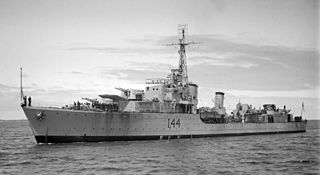
HMAS Warramunga (I44/D123) was a Tribal-class destroyer of the Royal Australian Navy (RAN). Built during World War II, the destroyer entered service in late 1942. She was initially assigned to convoy escort duties, but was assigned to the joint Australian-American Task Force 74 in 1943, and was involved in supporting numerous amphibious landings through the South-east Asian region until the end of the war. From 1950 and 1952, Warramunga fought in the Korean War, then was converted into an anti-submarine destroyer. Returning to service in 1954, the destroyer was one of the first RAN ships to operate with the Far East Strategic Reserve, and undertook two tours with the organisation before she was decommissioned in 1959 and sold for ship breaking in 1963.

British Commonwealth Forces Korea (BCFK) was the formal name of the British Commonwealth army, naval and air units serving with the United Nations (UN) in the Korean War. BCFK included Australian, British, Canadian, Indian, and New Zealand units. Some Commonwealth units and personnel served with United States and/or other UN formations, which were not part of BCFK.
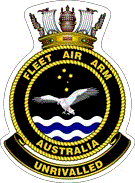
The Fleet Air Arm (FAA), known formerly as the Australian Navy Aviation Group, is the division of the Royal Australian Navy (RAN) responsible for the operation of aircraft. The FAA was founded in 1947 following the purchase of two aircraft carriers from the Royal Navy. FAA personnel fought in the Korean War and the Vietnam War, and participated in later conflicts and operations from host warships.

The history of the Royal Australian Navy traces the development of the Royal Australian Navy (RAN) from the colonisation of Australia by the British in 1788. Until 1859, vessels of the Royal Navy made frequent trips to the new colonies. In 1859, the Australia Squadron was formed as a separate squadron and remained in Australia until 1913. Until Federation, five of the six Australian colonies operated their own colonial naval force, which formed on 1 March 1901 the Australian Navy's (AN) Commonwealth Naval Force which received Royal patronage in July 1911 and was from that time referred to as Royal Australian Navy (RAN). On 4 October 1913 the new replacement fleet for the foundation fleet of 1901 steamed through Sydney Heads for the first time.
HMAS Nirimba is a former Royal Australian Navy (RAN) training base located at the former RAAF Station Schofields at Nirimba Fields, previously Schofields, in Sydney, New South Wales, Australia.

Australia entered the Korean War on 28 September, 1950; following the invasion of South Korea by North Korea. The war's origins began after Japan's defeat in World War II, which heralded the end to 35 years of Japanese occupation of the Korean Peninsula. The surrender of Japan to the Allied forces on 2 September 1945 led to the division of Korea into two countries, which were officially called the Democratic People's Republic of Korea (DPRK) and the Republic of Korea (ROK). The DPRK was occupied by the Soviet Union, and the ROK, below the 38th Parallel, was occupied by the United States (US).
Admiral Sir Victor Alfred Trumper Smith, was a senior officer in the Royal Australian Navy. Smith's career culminated with his appointment as chairman, Chiefs of Staff Committee—forerunner of the role of Australia's Chief of the Defence Force—from 1970 to 1975, following an earlier term as Chief of Naval Staff from 1968 to 1970.
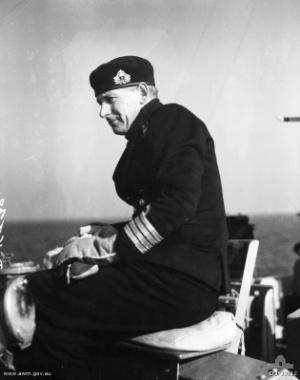
Rear Admiral Otto Humphrey Becher, & Bar was a senior officer in the Royal Australian Navy (RAN). Born in Harvey, Western Australia, Becher entered the Royal Australian Naval College in 1922. After graduating in 1926, he was posted to a series of staff and training positions prior to specialising in gunnery.

Vice Admiral Sir Henry Mackay Burrell, was a senior commander in the Royal Australian Navy (RAN). He served as Chief of the Naval Staff (CNS) from 1959 to 1962. Born in the Blue Mountains, Burrell entered the Royal Australian Naval College in 1918 as a 13-year-old cadet. His first posting at sea was aboard the cruiser HMAS Sydney. During the 1920s and 1930s, Burrell served for several years on exchange with the Royal Navy, specialising as a navigator. During World War II, he filled a key liaison post with the US Navy, and later saw action as commander of the destroyer HMAS Norman, earning a mention in despatches.

The order of battle of Australian forces during the Korean War consisted of one, and later two infantry battalions, naval forces of one aircraft carrier, two destroyers, and one frigate, as well as air forces consisting of one fighter squadron and one transport squadron. The first forces were committed in July 1950 from units based in Japan as part of the British Commonwealth Occupation Force, with Australia being the first UN member nation after the United States to commit elements from all three services. A total of 17,808 Australians served during the Korean War, including 1,193 members of the Royal Australian Air Force (RAAF), 5,771 from the Royal Australian Navy (RAN), and 10,844 from the Australian Army, with casualties including 341 killed and 1,216 wounded. Australian forces remained following the end of hostilities, with the last units finally departing in 1956.

Vice Admiral Sir Alan Wedel Ramsay McNicoll, was a senior officer in the Royal Australian Navy (RAN) and a diplomat. Born in Melbourne, he entered the Royal Australian Naval College at the age of thirteen and graduated in 1926. Following training and staff appointments in Australia and the United Kingdom, he was attached to the Royal Navy at the outbreak of the Second World War. As torpedo officer of the 1st Submarine Flotilla in the Mediterranean theatre, McNicoll was decorated with the George Medal in 1941 for disarming enemy ordnance. He served aboard HMS King George V from 1942, sailing in support of several Arctic convoys and taking part in the Allied invasion of Sicily. McNicoll was posted for staff duties with the Admiralty from September 1943 and was involved in the planning of the Normandy landings. He returned to Australia in October 1944.

Rear Admiral Galfry George Ormond Gatacre, was a senior officer in the Royal Australian Navy (RAN), who also played first-class cricket. His naval career began in 1921 and lasted until his retirement in 1964, during which time he spent a number of years on secondment to the Royal Navy. He saw action in both the Second World War and the Korean War, for which he was awarded the Distinguished Service Cross and the Distinguished Service Order. He also played first-class cricket in England for the Royal Navy Cricket Club. He was made a Commander of the Order of the British Empire in 1960 and, after retirement from the navy, he became a businessman.















